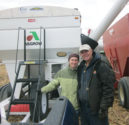Advertise Follow Us
Articles Tagged with ''profit''
No-Till Soybean Specialists Find Profitable Market Niche
After conquering the high-management requirements, Illinois no-tillers Matt and Connie Hughes are successfully no-tilling soybeans for seed production and raising non-GMO varieties to capture rising premiums.
Read More
Double-Cropping Veterans Share Expertise On Wheat, Soybeans
With attention to details, double-cropping systems cover the soil, improve soil health, ward off pests and diseases and protect profits, say veteran no-tillers John and Alexander Young.
Read More
Implement Guidance Paves The Way To Profitability
Technology that keeps field implements in line is gaining momentum as no-tillers and strip-tillers see increased yields, and lower input costs, through improved accuracy with field operations.
Read More
Fine-Tuning Fertility Makes Strip-Till More Profitable
Using precision technology, Paul and Mike Schweitzer continue to evolve their strip-till and fertilizer systems to slash input costs, preserve soil and water quality and achieve higher yields.
Read More
Matching Nitrogen Rates To Strip-Till Profitability
Through research, Minnesota strip-tiller David Legvold and college senior Emma Cornwell found the most profitable rate of sidedressed liquid 28% isn’t always the highest rate.
Read More
Tips For No-Tilling ‘Lean And Green’
No-tillers who do their own onfarm research can harvest the data needed to make better decisions about their farm systems and inputs.
Read More










